Catocala of Alberta
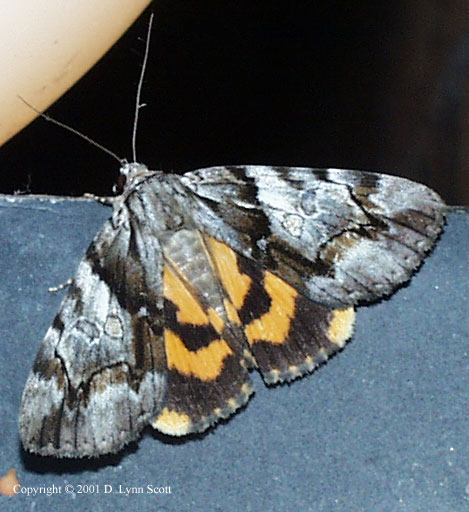
Catocala blandula
courtesy of Lynn Scott.
There are not too many species indigenous to Alberta
so identification is relatively easy if good images (usually need to see entire hindwing) are provided.
The following table divides all North American Catocala species (reported or anticipated in Alberta)
into twenty-one different groups. Moths are grouped according to
hindwing colour bands (yellow, orange, salmon, red, pink, black or
white) and wingspan measurements (small = 35-55mm, medium = 55-75 mm and
large = 75mm plus).
Wingspan refers to the
distance from wing tip to wing tip when the moths are spread with
the inner margin of the
forewing perpendicular to the body.
Those found in Alberta are located in their respective
groupings. There can be some natural variation in hindwing ground colour, and often there is a range from pinkish orange to deep red
for some of the willow feeders.
I will do my best to assist with identifications if you provide high qaulity images with data (at least date and location). Send jpg images
to Bill Oehlke. All images I post to my webpages are credited to photogrpahers and
remain the property of those photographers.
Many thanks to Gary Anweiler for his excellent coverage of Alberta Catocala.
PINK
mmmmmmmmmmmmmm
small
medium
large
mmmconcumbens |
BLACKmmmmmmm
|
WHITE
nnmmmmmmmmmm
relicta |
mmmmmmmmmm
|
|
Little Yellow-Orange Underwings: Wingspans: 35-50mm
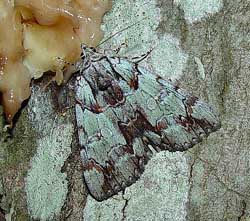
| ** 8865
praeclara; Praeclara Underwing,
wingspan: 40-50mm.
Fw pale greenish-grey with considerable contrasting
brown shading beyond post medial line.
There is a black basal dash very close to the inner margin and
another dash, higher up in the median area.
Note the contrasting shapes of the reniform and subreniform spots.
Upper of two larger pml teeth is longer, wider than lower tooth.
Note double, white filled amls.
Lighter, subcircular patch, outlined in black, brown on lower thorax.
|
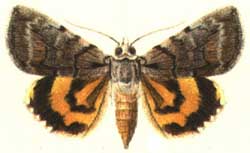
| ** 8865
praeclara manitoba; Manitoba Underwing, wingspan: 40-50mm
The forewing am line is black and distinct, oblique in its upper half and perpendicular to the inner margin
in its lower half. There is a distinct, narrow, white, toothed subterminal band.
The hindwing loop is complete.
|
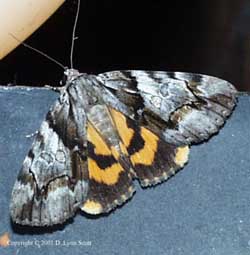
| ** 8867 Catocala blandula WO;
Charming Underwing; 40-50mm.
Fw pale basal area distinguishes mira from
blandula (dark brown) and crataegi (black).
Fw has dark contrasting lines as in crataegi.
There is also considerable brown in subterminal area
and subreniform spot is very conspicuous and usually brown. A
light area runs obliquely from the costa to the subreniform spot.
The hindwing is deep orange and has a complete inner black band.
The outer black band is unbroken.
Lynn Scott image.
|
Midsized Orange-Salmon-Red-Scarlet Underwings: Wingspans: 50-72mm
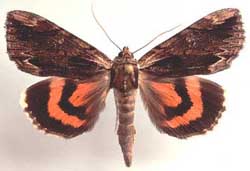
| ** 8857 Catocala ultronia;
Ultronia Underwing, wingspan: 50-63mm.
Fws typically gray-brown, with a distinct and very
dark inner margin and characteristic light brown patch, underscored
by very dark arc, near wingtip.
Underwings can be yellow to orange to salmon.
|
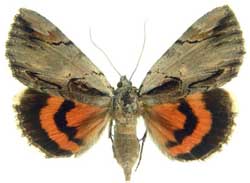
| ** 8857 Catocala ultronia form lucinda;
Ultronia Underwing, wingspan: 50-63mm.
In form lucinda most of the forewing
is bright grey. On all forms there is
extensive orange-salmon colouration on hw ventral surface,
and there is a dark discal lunule.
|
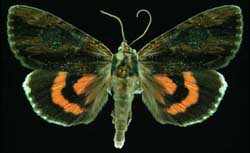
| Catocala ultronia,
form nigrescens, the Ultronia Underwing, wingspan: 50-63mm.
In the melanic form nigrescens, the dorsal forewing is very dark.
Even darker subapical arc, basal dash and dash near anal angle are still visible.
Dark basal hairs on hindwing.
Harold J. Vermes slide, used with permission from his son.
|
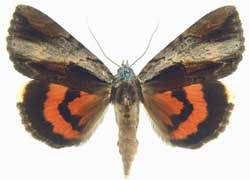
|
In form celia there is a wide, light grey band separating a dark region along inner margin and
a dark patch near the apex.
The ventral surface of forewings of all forms has a generous suffusion
of orange-salmon scales in the lower half of the median area.
|
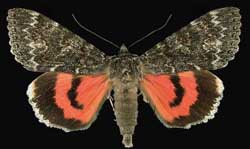
|
californica;
65mm.
Fws dark, gritty. Markings indistinct. Dark, large reniform spot; am and pm lines indistinct.
Subterminal line inwardly lined with light scales. Hw fringe white, checked halfway to outer edge with black,
black lines on veins extending through fringe. Some orange bleeding at apex. Black median band ends
well before im. June until August; willow or walnut??
|
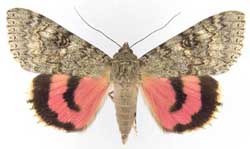
| Catocala hermia;
Hermia Underwing: 58-68mm; pinkish:
Fw almost uniform, grey-brown or clay coloured; thin, yet contrasting lines.
Distinct large double reniform spot. Large concolourous subrenifrom spot usually open.
Hw pinkish red, relatively even, narrow black bands. Inner black band ends before im.
Fringe white, checked, pink/red "bleeding" along outer band, near apex.
|
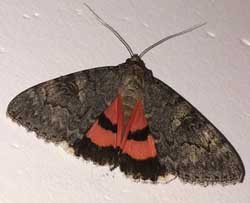
| Catocala hermia form vesta;
Hermia Underwing: 58-68mm; pinkish:
Fw almost uniform, very dark grey; thin, yet contrasting lines.
Distinct large double reniform spot. Large concolourous subrenifrom spot usually open.
Hw pinkish red, relatively even, narrow black bands. Inner black band ends before im.
Fringe white, checked, pink/red "bleeding" along outer band, near apex.
|
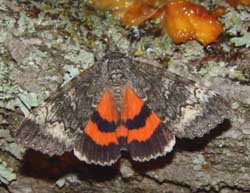
| #8817
briseis TT;
Briseis Underwing;
60-70mm;
Fws predominantly mottled dark-grey-brown with some lighter areas 1) between postmedial & subterminal lines, 2) at base of am & pm
lines along inner margin, 3) over subreniform spot running diagonally toward costa.
Pm lines do not have greatly elongated and sharly pointed "teeth" near apex.
Hw fringe white & unbroken, inner black band (fairly even) reaches inner margin.
Tim Dyson image.
|
|
Large Black Underwings (Banded): Wingspans: 70-80mm
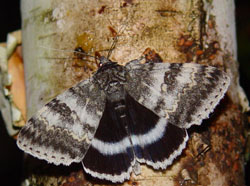
| ** 8803 Catocala relicta
;
Forsaken, White, Relict; 70-80mm:
Considerable variation with regard to black/white
concentrations on fws.
Typical specimens have basal and subterminal areas with
blackish scales.
Black hws, with brilliant even white inner band and
white fringe, are distinctive. June until October, probably N.& E; poplars and willows
|
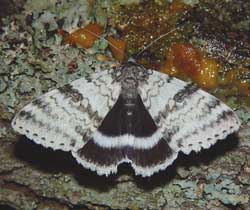
| ** 8803 Catocala relicta
;
Forsaken, White, Relict; 70-80mm:
Considerable variation with regard to black/white
concentrations on fws.
Form clara: basal and subterminal
areas predominantly white.
Typical specimens have basal and subterminal areas with
blackish scales. Black hws, with brilliant even white inner band and
white fringe, are distinctive. June until October.
|
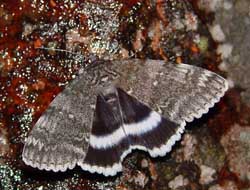
| ** 8803 Catocala relicta
;
Forsaken, White, Relict; 70-80mm:
Considerable variation with regard to black/white
concentrations on fws.
Form phrynia:
evenly dusted with grey over entire forewing.
Typical specimens have basal and subterminal areas with
blackish scales. Black hws, with brilliant even white inner band and
white fringe, are distinctive. June until October; poplars and willows
|
Large Orange-Salmon Underwings: Wingspans: 65mm, usually 70-95mm
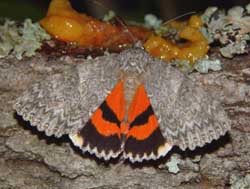
| ** 8822
meskei TT; Meske's Underwing;
65-75mm.
Fws less distinctly marked compared to unijuga,
some red-orange at the hindwing apex and just inside the
fringe along the outer margin in meskei that is lacking in unijuga.
Fw subreniform spot is opened or connected to the
postmedian line. The hindwing postmedian band nearly straight,
turned in and tapering near anal angle.
Tim Dyson image. |
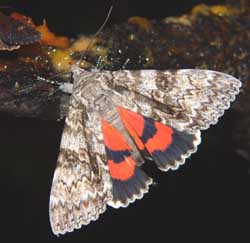
| ** 8821
semirelicta; Semirelict Underwing;
65-75mm.
Fw ground colour is white with dark lines and shadings.
Diffuse dark bar runs from center of basal area to outer margin a
few mm above anal angle. Note regular dentation of st line.
Inner black bar on hw usually terminates well before
the inner margin.
The form "atala" has a forewing that is uniformly grey.
Unijuga is usually larger and has less contrasting black lines. The
inner black bar on unijuga usually reaches the inner margin.
Tim Dyson image.
|
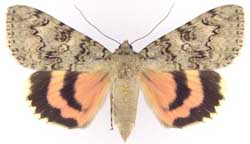
| ** 8808 luciana;
Luciana Underwing; 70-80mm.
Luciana has pale grey brown fw with very distinct am
& pm lines.
Subreniform spot has elongated narrow "tail" that seems to
open through postmedial line.
Hw inner black band does not reach inner margin.
Fringe is checked and paler (almost yellow) than
salmon ground colour.
|
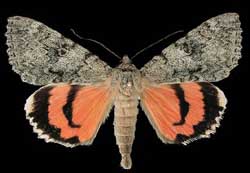
| Catocala junctura;
Joined Underwing; 67-85mm.
Fw usually dark brownish-gray to evenly powdered
blue-grey w/o significant markings. Doubled reniform spot
often obscure. Thin, slightly darker am & pm
lines run from costa to im and are not widely
spaced at im.
Hw salmon or orange-pink, narrow inner black band
turns in sharply, does not meet dark-haired im,
distinguishing it from unijuga.
Gary Anweiler image. |
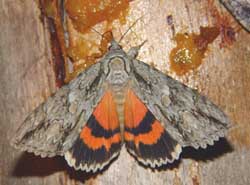
| ** 8806 Catocala parta;
Mother Underwing; 70-85mm.
The black dashes in the basal, subapical and anal areas help to
identify this species. The hindwings may be yellow to
yellowish-orange but more often are salmon-red. Note the
face-head-like markings on the thorax.
In the hindwing, the first (nearest the apex) black protrusion into
the white fringe is "noticeably" larger than the others.
|
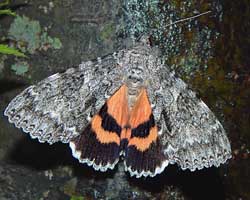
| ** 8805 unijuga;
Once-married; 70-90mm. Unijuga has
fairly wide black hw inner band (almost reaching inner margin), dark hairs in basal-median area along hw im;
very distinctive patterning in forewing.
Meskei tend to have narrower band and dustier (less distinct) looking fw.
Semirelicta tend to have inner bands that terminate well before
inner margins. Also note the very white fringe on both the forewings and hindwings.
Carroll Rudy image.
|
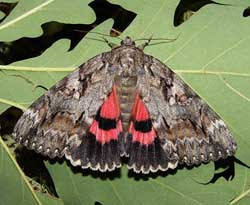
| aholibah;
80-90mm: Fw is mix of grey and brown, with preponderance of brown in subterminal area.
Double reniform spot has diffuse brown outline of inner oval. Subreniform spot is small,
distinctly outlined in black,
light coloured and does not connect to pm line. Upper two teeth of pm line are elongate
and are followed by relatively smooth line til next tooth below the subreniform spot.
Hindwing salmon or pinkish.
|
|
Medium-Large Pink Underwings: Wingspans: 70-95mm
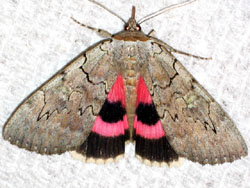
| ** 8833 concumbens
Sleepy Underwing or
Pink Underwing; 60-75mm.
This brown thoracic collar is quite evident in this image as is the
interruption in the pm line by the open subreniform spot.
The white hindwing fringe is only lightly checked
on the wing veins. The vibrant pink bans are
distinct in colour and also in their relatively smooth contour.
|
|
|
Return to Canadian Index
Return to Main Index
Felix Sperling writes, "I just found a good example of how our
University of Alberta Virtual
Museum
http://www.entomology.ualberta.ca/ can be useful for doing
historical searches.
"A colleague gave me an obituary from the London Times for George
Salt, who died in England Feb. 17th, 2003, aged 99. George Salt grew
up in Calgary and attended the University of Alberta. After time at
Harvard, and much travel and research around the world, he ended up
as Reader in Animal Ecology at Cambridge University, doing classic
research on insect parasites along the way.
"A search of our Virtual Museum site, using "Salt, George" from the
list of collectors in the specimen search function, shows that we
have databased about 60 specimens, from 39 species, in the University
of Alberta Strickland Museum that were collected by George Salt. Most
are lepidoptera, including lots of moths, but also one beetle, and
most are from Calgary during 1919 to 1922, when he would have been
15-18 years old.
"Check it out! Notice that if you click on the blue "Collector" above
the box in the specimen search that allows you to search for
collectors, then you will get an alphabetized list of all collectors.
"Felix Sperling
"ps: If any of you have a website link to the Virtual Museum page,
could you please change it to the url above! This new internet
address will help us to make the Virtual Museum searchable via
Google. However, before the Google Crawler can be enticed into
indexing our species pages, we need to have as many links as possible
to the site above from other web pages. Thanks!"
I visited the Museum's data base and find it
excellent for finding info about species flight times and local distributions.
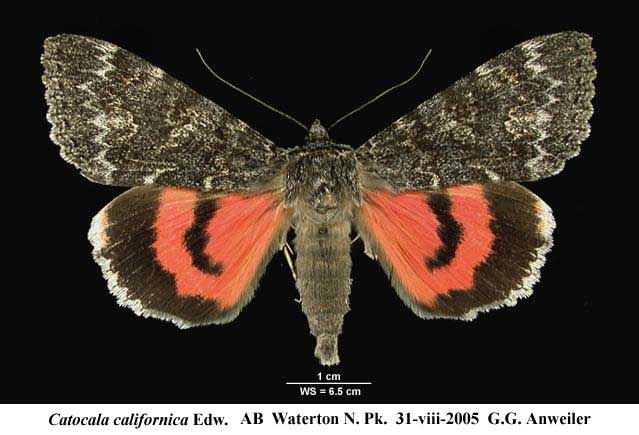
Catocala californica, Waterton National Park, Alberta,
courtesy of Gary Anweiler.
Use your browser "Back" button to return to the previous page.
This page is brought to you by Bill Oehlke and the WLSS.
Pages are on space rented from Bizland. If you would like to become a "Patron of the Sphingidae and/or Catocala Sites",
contact Bill.
Please send sightings/images to Bill. I will do my best to respond to requests for identification help.
Enjoy one of nature's wonderments: Live Saturniidae (Giant Silkmoth) cocoons.


